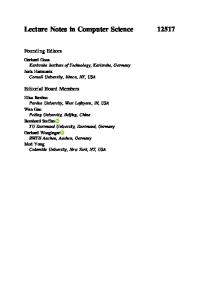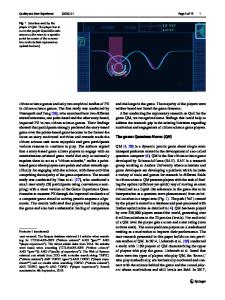Asymmetrical Multiplayer Versus Single Player: Effects on Game Experience in a Virtual Reality Edutainment Game
Gamification of learning material is becoming popular within the education field and the possibilities of designing edutainment games are being explored. This project compares a single player and a two-player game experience in a collaborative Virtual Rea
- PDF / 56,232,927 Bytes
- 489 Pages / 439.37 x 666.142 pts Page_size
- 50 Downloads / 260 Views
Lucio Tommaso De Paolis Patrick Bourdot (Eds.)
Augmented Reality, Virtual Reality, and Computer Graphics 7th International Conference, AVR 2020 Lecce, Italy, September 7–10, 2020 Proceedings, Part I
Lecture Notes in Computer Science Founding Editors Gerhard Goos Karlsruhe Institute of Technology, Karlsruhe, Germany Juris Hartmanis Cornell University, Ithaca, NY, USA
Editorial Board Members Elisa Bertino Purdue University, West Lafayette, IN, USA Wen Gao Peking University, Beijing, China Bernhard Steffen TU Dortmund University, Dortmund, Germany Gerhard Woeginger RWTH Aachen, Aachen, Germany Moti Yung Columbia University, New York, NY, USA
12242
More information about this series at http://www.springer.com/series/7412
Lucio Tommaso De Paolis Patrick Bourdot (Eds.)
•
Augmented Reality, Virtual Reality, and Computer Graphics 7th International Conference, AVR 2020 Lecce, Italy, September 7–10, 2020 Proceedings, Part I
123
Editors Lucio Tommaso De Paolis University of Salento Lecce, Italy
Patrick Bourdot University of Paris-Sud Orsay, France
ISSN 0302-9743 ISSN 1611-3349 (electronic) Lecture Notes in Computer Science ISBN 978-3-030-58464-1 ISBN 978-3-030-58465-8 (eBook) https://doi.org/10.1007/978-3-030-58465-8 LNCS Sublibrary: SL6 – Image Processing, Computer Vision, Pattern Recognition, and Graphics © Springer Nature Switzerland AG 2020 This work is subject to copyright. All rights are reserved by the Publisher, whether the whole or part of the material is concerned, specifically the rights of translation, reprinting, reuse of illustrations, recitation, broadcasting, reproduction on microfilms or in any other physical way, and transmission or information storage and retrieval, electronic adaptation, computer software, or by similar or dissimilar methodology now known or hereafter developed. The use of general descriptive names, registered names, trademarks, service marks, etc. in this publication does not imply, even in the absence of a specific statement, that such names are exempt from the relevant protective laws and regulations and therefore free for general use. The publisher, the authors and the editors are safe to assume that the advice and information in this book are believed to be true and accurate at the date of publication. Neither the publisher nor the authors or the editors give a warranty, expressed or implied, with respect to the material contained herein or for any errors or omissions that may have been made. The publisher remains neutral with regard to jurisdictional claims in published maps and institutional affiliations. This Springer imprint is published by the registered company Springer Nature Switzerland AG The registered company address is: Gewerbestrasse 11, 6330 Cham, Switzerland
Preface
Virtual Reality (VR) technology permits the creation of realistic-looking worlds where the user inputs are used to modify in real time the digital environment. Interactivity contributes to the feeling of immersion in the virtual world, of being part of the action that the user experiences. It











